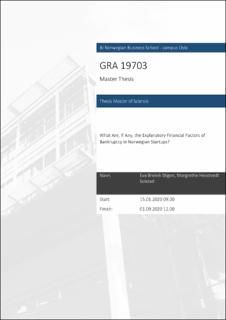What are, if any, the explanatory financial factors of bankruptcy in Norwegian startups?
Master thesis

View/
Date
2020Metadata
Show full item recordCollections
- Master of Science [1621]
Abstract
In this paper, we investigate startups that have survived the first crucial years, but
which then went bankrupt during the following years. The intention behind this
focus is to acknowledge why some startups do not cross the chasm.
A logistic regression model was designed with several variables to explain
bankruptcy. The usage of the Akaike Information Criterion (AIC) was central to
narrow down relevant variables alongside significance and z-statistics. Robustness
has also been tested for the explanatory variables. In general, one could say that
since the solvency ratios were the most dominant explanatory factors, which
indicate how Norwegian startups have a negative net worth and a non-manageable
debt level. Since Norwegian startups hold less liquid assets, one important issue is
the amount of untapped cash within the organization. The industries that
experienced bankruptcy the most were (i) water supply; sewerage, waste
management, and remediation activities, (ii) construction, (iii) transportation and
storage, and (iv) accommodation and food service activities. One thing these
industries have in common is the number of tangible assets . As a result, the
tangible assets could be more difficult to quickly transform into cash.
Interaction effects have not been considered, nor dynamic effects or firm
fixed effects. The variables that have been tested have previously been tested on
public and listed companies, and not on startups. The findings could be used to
greater understand the financial struggles Norwegian startups have. The different
actors that could find the findings useful are angel investors, venture capitalists,
the authorities, and most important the entrepreneur and the Norwegian startup
environment.
The concept of bankrupt startups often concerns aspects connected to the
entrepreneur and not necessarily underlying financial reasons. Therefore, this
master thesis could contribute to filling an important knowledge gap within the
research field.
Keywords: Startups, financial explanatory factors, Norway, financial ratios, bankruptcy,
financial statement analysis, capital structure, AIC, logistic regression.
Description
Masteroppgave(MSc) in Master of Science in Business, Accounting and Business Control - Handelshøyskolen BI, 2020